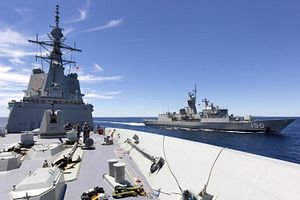The Royal Australian Navy’s (RAN) first-of-class air warfare destroyer HMAS Hobart has conducted its first-ever replenishment at sea (RAS) with the lead ship of the Anzac–class, the frigate HMAS Anzac, off the east coast of Australia this month, the Australian Ministry of Defense (MoD) reports.
The maneuver occurred as HMAS Hobbart, one of the most technologically complex and capable warships ever to be operated by the RAN, has conducted other first-of-class trials including launching test torpedoes, anti-air gunnery trials, and firing the ship’s close in weapon system.
“We wanted to get our first RAS right and set the standard for what I expect to be hundreds of similarly successful replenishments in Hobart’s future”, the ship’s commanding officer, Captain John Stavridis, said.
The 7,000-ton HMAS Hobart, commissioned in September 2017, is the first RAN surface warship built around the U.S. made Aegis combat system, centered around one of the most technologically advanced phased-array radars currently in service. As I noted March 2017:
Each ship will be equipped with the AN/SPY-1, an advanced, automatic detect and track, multi-function phased-array radar system, which will be paired with the MK 41 Vertical Launching System, capable of firing Raytheon’s Standard Missiles (SM) of all variants as well as the RIM-162 Evolved Sea Sparrow Missile.
In December 2017, the Australian MoD also announced that the Hobart-class will be fitted with Raytheon’s so-called cooperative engagement capability (CEC), which allows the real-time sharing of sensor data on air targets, including incoming enemy aircraft and cruise missiles, between CEC-equipped units.
The HMAS Hobbart “is equipped with modern sonar systems and surface-launched torpedoes for anti-submarine warfare, as well as Harpoon anti-ship missiles for surface warfare missions,” I wrote last year. “The Hobart will also carry helicopters and unmanned aerial vehicles (UAVs).”
Furthermore, I noted that Hobbart-class destroyers are “multi-purpose weapons platforms that can be used for anti-surface and anti-submarine warfare operations, as well as gunfire support roles, next to the defending naval task forces from aircraft and missile attacks.”
The Hobart-class program has been plagued by multiple delays over the last decade, which has substantially increased development and procurement costs, now estimated at over $8 billion. This makes it one of Australia’s most expensive weapons program to date.
As I reported elsewhere, one of the principal reasons for steep cost increases are required upgrades to the ship’s Aegis combat system following commissioning.
The second and third ship of the class, the HMAS Brisbane and HMAS Sydney, are slated for delivery in September 2018 and March 2020. The HMAS Hobbart is expected to deploy for the first time later this year.
































